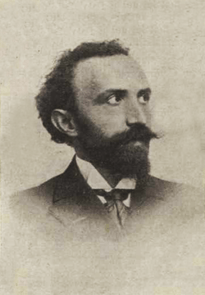Arshag Chobanian
| Arshag Chobanian | |
|---|---|
 | |
| Born |
15 July 1872 Beşiktaş, Constantinople, Ottoman Empire |
| Died |
9 June 1954 (aged 81) Paris, France |
| Occupation | Short story writer, poet, writer, translator, playwright, and literary critic. |
Arshag Chobanian (Armenian: Արշակ Չոպանեան; July 15, 1872 – June 9, 1954), was an Armenian short story writer, journalist, editor, poet, translator, literary critic, playwright, philologist, and novelist.[1]
Biography
Arshag Chobanian was born in the Beşiktaş district of Constantinople to an Armenian family whose origins go back to the village of Agn (Kemaliye).[1] His mother died when he was about a month old and his father was a respected goldsmith.[2] He received his education from the local Makruhian school. He later transferred to the prestigious Getronagan Varjaran (Central Lyceum) in Karakoy. After graduating from the lyceum, he started to write for the Hayrenik (Fatherland) Armenian newspaper whose editorial board consisted of famed writers such as Levon Pashalian, Arpiar Arpiarian, and Krikor Odian.[1] In 1893, after gaining international appeal with his first play Mut Khaver (Dark Stratas), he was invited to Paris for an honorarium. There he met famed literary figures such as Émile Zola, François Coppée, Alphonse Daudet, Jean Lorrain, and Madame Caroline Severine.[1] In 1894 he became editor-in-chief of the Armenian newspaper Tsaghik (Flower). In 1895, after hearing about the Armenian massacres, he chose to remain in Paris and did so the rest of his life.[1][3]
In 1898 he founded his famous periodical Anahit.[1][3] His connections and acquaintances with prominent literary and intellectual figures in France allowed him to write about the Armenian massacres and injustices freely in popular French newspapers such as Mercure de France. He became a strong advocate of western support in order to save the Armenians from the oppression of the Ottoman government.[4] After joining the Ramgavar party, he met with Boghos Nubar and participated in the Armenian National Delegation during the Paris Peace Conference of 1919.[5] In 1933 he visited Soviet Armenia and met with prominent intellectuals. After returning to Paris, he died on June 9, 1954.
Literary career

Arshag Chobanian is considered one of the fundamental Armenian realist writers, though he also has many works in the romantic style as well.[1] His first essays were published in 1891, in a booklet called Arshaluysi Tsayner (The sounds of dawn), followed by a series of poems called Trtrumner (Shudderings) in 1892. These initial works were followed by his first novel Tughti Parki(The glory of paper). After writing his first play Mut Khaver (Dark Strats), he was invited to Paris for an honorarium. His early works tend to be romantic but after meeting and appreciating Arpiar Arpiarian, a realist writer himself, he began writing in the realist style. However, he never fully ceased writing in romantic style.[1] In 1894 he published the works of Bedros Tourian and provided his own analysis to his poems. This work was important in reviving Bedros Tourian's poetry which at the time was being undermined in terms of its value. In 1907 Chobanian published a critical study of famed poet Mkrtich Beshiktashlian which included a series of his own poems. Demker (Portraits) was a two volume set of literary critics of contemporary Armenian writers. In his study of Grigor Naregatsi, the tenth century Armenian religious mystic, Chobanian considers Madyan Voghperkuyuni (Book of lamentations) one of the greatest literary pieces in world literature and it is due to Chobanian's insight that Grigor Naregatsi has gained such repute.[1]
Chobanian did extensive research on medieval Armenian poetry. He recovered ancient Armenian poems and songs known as Hayrens and published them in two volumes, Nahapet Kuchaki Divani (The collected poems of Nahabet Kuchak, 1902) and Hayreni Purastan (Gardens of Armenian poems, 1940).
His literary periodical Anahit served as an important literary source for Armenian literature and played a crucial role in the Armenian literary, cultural, philological movement. Lasting for almost three decades during two separate intervals (1898-1911; 1929-1949), it gathered some of the most prominent figures in the Armenian literary scene who revered it as an outstanding achievement in the Armenian literature.[1]
He introduced Armenian history, arts, and literature in French intellectual circles by writing in prestigious periodicals such as Revue Blanche, Revue de Revues, Revues de Encyclopedie, and more. Among some of the readers of these writings was famed French novelist and writer Anatole France, who thereafter sympathized with the plight of the Armenian people.[1] Chobanian translated many Armenian poems into French, which culminated in a three volume work called Roseraie d'Armenie (Rose Garden of Armenia 1918-1929). Chopanian wrote literary criticism of European writers such as Emile Verhaeren, Honoré de Balzac, Victor Hugo, Émile Zola, Henrik Ibsen, and many more.
References
| Wikimedia Commons has media related to Arshag Chobanian. |
- 1 2 3 4 5 6 7 8 9 10 11 Hacikyan, Agop; Gabriel Basmajian; Edward S. Franchuk (2005). Nourhan Ouzounian, ed. The Heritage of Armenian Literature Volume III: From the Eighteenth Century to Modern Times. Detroit, MI: Wayne State University Press. pp. 680–683. ISBN 0-8143-2815-6. Retrieved 19 October 2011.
- ↑ Bedevian, Ruth. "Arshag Tchopanian". ArmenianHouse.org is an electronic library featuring a collection of Armenian literature and history. Armenianhouse. Retrieved 21 October 2011.
- 1 2 Chahinian, Talar (September 20, 2008). "Mapping Armenian literature in the diaspora". Armenian Reporter. Retrieved 19 October 2011.
- ↑ "Arshag Chobanian". The Free Dictionary. Retrieved 21 October 2011.
- ↑ Moumdjian, Garabet. "The Republic of Armenia, 1918-1921". Armenian History. armenian-history.com. Retrieved 21 October 2011.